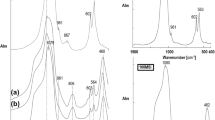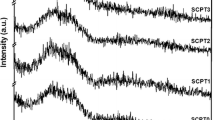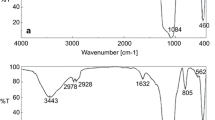Abstract
The development of systems that can prevent infections and also ensure bone integration as well as regeneration have been of great interest for pharmaceutical technology. In this study, we show the synthesis of surface-functionalized mesoporous silica (SBA-16) and silica composed of calcium phosphate (SBA-16/HA) particles in order to be applied as efficient drug delivery carriers. The particles were synthesized, functionalized with 3-aminopropyltriethoxysilane (APTES) by post-synthesis grafting and loaded with the osteomyelitis antibiotic agent ciprofloxacin. Moreover, the diethylenetriaminepentacetic acid (DTPA) was anchored in silica-APTES to allow measurements of biological process at molecular and cellular levels. Particles were physicochemically characterized by small angle X-ray scattering (SAXS), elemental analysis (CHN), thermogravimetric analysis (TGA), N2 adsorption and zeta potential analysis. Functionalized silica particles were radiolabeled with technetium-99m showing high radiochemical yields and high radiolabeled stability. In vivo experiments results showed higher bone uptake of the SBA-16/HAAPTES than SBA-16APTES. In addition, bactericidal efficacy of these particles was tested against microorganisms present in bone infection, and our composites had bactericidal efficiency comparable to free-ciprofloxacin. In summary, taking into account the great potential of these silica mesoporous and nanocomposite structures to carry molecules, besides their bactericidal efficacy, these materials are promising candidates for bone infection treatment.
Graphical abstract









Similar content being viewed by others

References
Arcos D, Vallet-Regí M (2010) Sol-gel silica-based biomaterials and bone tissue regeneration. Acta Biomater 6:2874–2888. https://doi.org/10.1016/j.actbio.2010.02.012
Devanand Venkatasubbu G, Ramasamy S, Ramakrishnan V, Kumar J (2011) Nanocrystalline hydroxyapatite and zinc-doped hydroxyapatite as carrier material for controlled delivery of ciprofloxacin. 3 Biotech 1:173–186. https://doi.org/10.1007/s13205-011-0021-9
Andersson DI, Hughes D (2010) Antibiotic resistance and its cost: is it possible to reverse resistance? Nat Rev Microbiol 8:260–271. https://doi.org/10.1038/nrmicro2319
Capeletti LB, Oliveira LF De, Gonçalves KDA, et al. (2014) Tailored silica-antibiotic nanoparticles: overcoming bacterial resistance with low cytotoxicity. https://doi.org/10.1021/la4046435
Drlica K (1999) Mechanism of fluoroquinolone action. Curr Opin Microbiol 2:504–508. https://doi.org/10.1016/S1369-5274(99)00008-9
Redgrave LS, Sutton SB, Webber MA, Piddock LJ (2014) Fluoroquinolone resistance: mechanisms, impact on bacteria, and role in evolutionary success. Trends Microbiol 22:438–445
Kim HW, Knowles JC, Kim HE (2004) Hydroxyapatite/poly(??-caprolactone) composite coatings on hydroxyapatite porous bone scaffold for drug delivery. Biomaterials 25:1279–1287. https://doi.org/10.1016/j.biomaterials.2003.07.003
Blasi F, Aliberti S, Tarsia P (2007) Clinical applications of azithromycin microspheres in respiratory tract infections. Int J Nanomed 2:551–559
Tang F, Li L, Chen D (2012) Mesoporous silica nanoparticles: synthesis, biocompatibility and drug delivery. Adv Mater 24:1504–1534. https://doi.org/10.1002/adma.201104763
Cassidy JW (2015) Nanotechnology in the regeneration of complex tissues. Bone Tissue Regen Insights 5:25–35. https://doi.org/10.4137/BTRI.S12331.Nanotechnology
Juhasz JA, Best SM (2012) Bioactive ceramics: processing, structures and properties. J Mater Sci 47:610–624. https://doi.org/10.1007/s10853-011-6063-x
Wu C, Chang J (2012) Mesoporous bioactive glasses: structure characteristics, drug/growth factor delivery and bone regeneration application. Interface Focus 2:292–306. https://doi.org/10.1098/rsfs.2011.0121
Valente FL, Reis ECC, Sepúlveda RV et al. (2016) Hydroxyapatite, polycaprolactone and alendronate composites for bone regeneration in rabbits’ olecranon: histological features. Arq Bras Med Vet e Zootec 68:543–547. https://doi.org/10.1590/1678-4162-8343
Dasgupta S, Banerjee SS, Bandyopadhyay A, Bose S (2010) Zn- and Mg-doped hydroxyapatite nanoparticles for controlled release of protein. Langmuir 26:4958–4964. https://doi.org/10.1021/la903617e
Andrade GF, Gomide VS, da Silva Júnior AC et al. (2014) An in situ synthesis of mesoporous SBA-16/hydroxyapatite for ciprofloxacin release: in vitro stability and cytocompatibility studies. J Mater Sci Mater Med 25:2527–2540. https://doi.org/10.1007/s10856-014-5273-6
Andrade GF, Carvalho JL, Júnior ASC et al. (2015) Osteogenic differentiation of adipose-derived stem cells in mesoporous SBA-16 and SBA-16 hydroxyapatite scaffolds. RSC Adv 5:54551–54562. https://doi.org/10.1039/C5RA07330H
Gobin OC (2006) SBA-16 materials synthesis, diffusion and sorption properties. Laval University, Ste-Foy, Quebec, Canada
Díaz A, López T, Manjarrez J et al. (2006) Growth of hydroxyapatite in a biocompatible mesoporous ordered silica. Acta Biomater 2:173–179. https://doi.org/10.1016/j.actbio.2005.12.006
Izquierdo-Barba I, Sousa E, Doadrio JC et al. (2009) Influence of mesoporous structure type on the controlled delivery of drugs: Release of ibuprofen from MCM-48, SBA-15 and functionalized SBA-15. J Sol-Gel Sci Technol 50:421–429. https://doi.org/10.1007/s10971-009-1932-3
Andrade GF, Soares DCF, dos Santos RG, Sousa EMB (2013) Mesoporous silica SBA-16 nanoparticles: synthesis, physicochemical characterization, release profile, and in vitro cytocompatibility studies. Microporous Mesoporous Mater 168:102–110. https://doi.org/10.1016/j.micromeso.2012.09.034
de Barros ALB, de Oliveira Ferraz KS, Dantas TCS et al. (2015) Synthesis, characterization, and biodistribution studies of 99mTc-labeled SBA-16 mesoporous silica nanoparticles. Mater Sci Eng C 56:181–188. https://doi.org/10.1016/j.msec.2015.06.030
Ehlert N, Badar M, Christel A et al. (2011) Mesoporous silica coatings for controlled release of the antibiotic ciprofloxacin from implants. J Mater Chem 21:752. https://doi.org/10.1039/c0jm01487g
Cueva C, Moreno-Arribas MV, Martín-Álvarez PJ et al. (2010) Antimicrobial activity of phenolic acids against commensal, probiotic and pathogenic bacteria. Res Microbiol 161:372–382. https://doi.org/10.1016/j.resmic.2010.04.006
Beck JS, Vartuli JC, Roth WJ, et al. (1992) A new family of mesoporous molecular sieves prepared with liquid crystal templates. J Am Chem Soc 10834. https://doi.org/10.1021/ja00053a020
Costa JAS, Garcia ACFS, Santos DO et al. (2014) A new functionalized MCM-41 mesoporous material for use in environmental applications. J Braz Chem Soc 25:197–207. https://doi.org/10.5935/0103-5053.20130284
Pang J, Zhao L, Zhang L et al. (2013) Folate-conjugated hybrid SBA-15 particles for targeted anticancer drug delivery. J Colloid Interface Sci 395:31–39. https://doi.org/10.1016/j.jcis.2012.12.016
Mouriño V, Boccaccini AR (2010) Bone tissue engineering therapeutics: controlled drug delivery in three-dimensional scaffolds. J R Soc Interface 7:209–227. https://doi.org/10.1098/rsif.2009.0379
Gao P, Nie X, Zou M et al. (2011) Recent advances in materials for extended-release antibiotic delivery system. J Antibiot64:625–634. https://doi.org/10.1038/ja.2011.58
Moritz M, Geszke-Moritz M (2015) Mesoporous materials as multifunctional tools in biosciences: principles and applications. Mater Sci Eng C Mater Biol Appl 49:114–151. https://doi.org/10.1016/j.msec.2014.12.079
Babić S, Horvat AJM, Mutavdžić Pavlović D, Kaštelan-Macan M (2007) Determination of pKa values of active pharmaceutical ingredients. TrAC Trends Anal Chem 26:1043–1061. https://doi.org/10.1016/j.trac.2007.09.004
Berridge MV, Herst PM, Tan AS (2005) Tetrazolium dyes as tools in cell biology: new insights into their cellular reduction. Biotechnol Annu Rev 11:127–152. https://doi.org/10.1016/S1387-2656(05)11004-7
Bancos S, Tsai D-H, Hackley V et al. (2012) Evaluation of viability and proliferation profiles on macrophages treated with silica nanoparticles in vitro via plate-based, flow cytometry, and coulter counter assays. ISRN Nanotechnol 2012:1–11. https://doi.org/10.5402/2012/454072
Pereira VV, Silva RR, Duarte LP, Takahashi JA (2016) Chemical constituents of Jacaranda oxyphylla and their acetylcholinesterase inhibitory and antimicrobial activities. Rec Nat Prod 10:392–396
de Barros ALB, Mota L das G, Ferreira C de A, Cardoso VN (2012) Kit formulation for 99mTc-labeling of HYNIC-ΒAla-Bombesin (7–14). Appl Radiat Isot 70:2440–2445. https://doi.org/10.1016/j.apradiso.2012.06.022
Shin SJ, Beech JR, Kelly KA (2012) Targeted nanoparticles in imaging: paving the way for personalized medicine in the battle against cancer. Integr Biol 5:29–42. https://doi.org/10.1039/c2ib20047c
James H, Thrall HAZ (2003) Medicina Nuclear. In: G Koogan (ed) 2a edn. p. 408. ISBN 852770790X
Acknowledgements
This work was supported by funding from CAPES, CNPq, and FAPEMIG. Experiments and analyses involving electron microscopy were performed in the Microscopy Center of the Federal University of Minas Gerais, Belo Horizonte, Brazil (http://www.microscopia.ufmg.br). The authors thank the LNLS (Campinas, Brazil) for Synchrotron radiation measurements.
Author information
Authors and Affiliations
Corresponding author
Ethics declarations
Conflicts of interest
The authors declare that they have no competing interests.
Rights and permissions
About this article
Cite this article
Andrade, G.F., Faria, J.A.Q.A., Gomes, D.A. et al. Mesoporous silica SBA-16/hydroxyapatite-based composite for ciprofloxacin delivery to bacterial bone infection. J Sol-Gel Sci Technol 85, 369–381 (2018). https://doi.org/10.1007/s10971-017-4557-y
Received:
Accepted:
Published:
Issue Date:
DOI: https://doi.org/10.1007/s10971-017-4557-y



